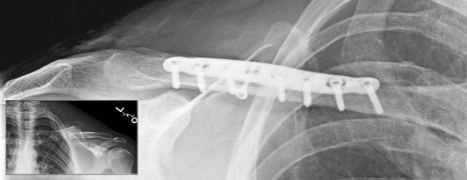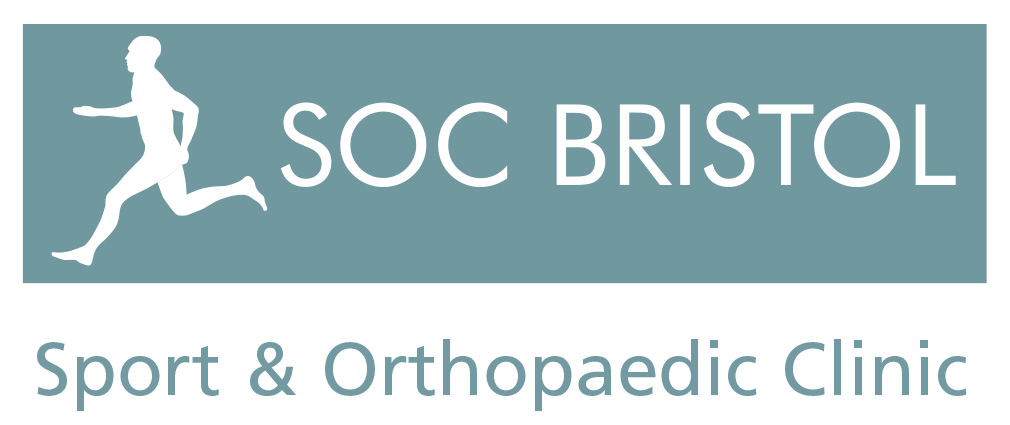Midshaft clavicle fracture surgical fixation.
Clavicle fractures are not a single entity and may have varying outcomes depending on the location and type of fracture . The management should be carefully chosen dependent both on the fracture and the individual who has the sustained the fracture.
The following section deals with the most common type of fracture that occurs in the mid portion of the Clavicle.
Anatomy:
The Clavicle (Collar bone) lies at the base of the neck between the Sternum (breast bone) and the Acromion of the Scapula (Shoulder blade).
The image below is an X-Ray of a displaced Clavicular fracture (inset) and post fixation with a locking plate. (Courtesy of AcumedTM).

Indication for surgery:
Given that mid-shaft Clavicle fractures with little displacement usually heal well these can typically be satisfactorily treated without surgery. However, in certain circumstances including the presence of significant displacement or shortening (overlap) of the clavicle there is increasing evidence to support early surgical fixation. This surgical stabilisation may reduce the associated deformity or mal-union and reduce the risk of a non-union with certain fracture patterns.
Midshaft Clavicle fractures may be stabilised surgically using open reduction and internal fixation (using a plate and screws) or intramedullary fixation (using a rod passed down the centre of the bone). There are advantages and disadvantages to each technique.
Alternative non-operative treatment:
The majority of clavicle fractures can be treated with a supportive PolyslingTM type sling. Alternative immobilisation with a brace or figure of eight support can be used. There is little evidence to support improved outcome with any particular method of support. The support is typically used for 4 to 6 weeks.
Anaesthetic:
The surgery is typically undertaken with the patient asleep.
Incisions:
The fracture can normally be reduced and stabilised with a plate through an incision approximately 5cm long. The length of the scar will depend on the length of the plate that in turn depends on the degree of fragmentation of the Clavicle. There are advantages to placing the incision a few centimetres below the Clavicle and orientated slightly obliquely to minimise scaring.
The wound is typically closed with MonocrylTM a dissolvable suture. This means there are no stitches to be removed but occasionally the ends of the suture may need to be trimmed. The wound is typically protected with Steri-StripsTM and an antiseptic gauze dressing covered by a splash-proof OpsiteTM dressing.
The dressing can usually be left in place for 10-14 days when it can be removed and the wounds inspected.
Procedure:
The fracture fragments are reduced (re-positioned) into their correct alignment and stabilised using a metal plate and screws.
Alternative procedures involve the placement of a rod or nail down the inside of the bone. There is typically a scar over the fracture (or break) and at the back of the shoulder to allow insertion of the pin.
The following video is provided by AcumedTM who are one of the manufacturers of anatomically designed plates specifically for the clavicle.
Rehabilitation:
Following the surgery the arm is usually placed in a PolyslingTM. Specific gentle exercises can be undertaken immediately following surgery under the guidance of a physiotherapist. The sling is typically worn for between 3 and 6 weeks.
Driving is usually possible by 6 to 8 weeks and a return to sport at 12-16 weeks depending on progress and follow up.
Please see the link to post clavicle fracture rehabilitation guidelines.
Risks associated with the operation:
All operations are associated with a degree of risk. The risk of complications is higher in those who smoke or use Tobacco products and consideration should be given to stopping use before surgery.
Scar.
Typically a 5cm scar over the front of the chest just below the Clavicle. Occasionally the scar may become hypertrophic or Keloid (raised and red). There is usually a patch of skin that feels numb or desensitised just below the scar. This numbness often improves with time but may be permanent.
Prominence and removal of metalwork.
The skin over the Clavicle is normally relatively thin and the Clavicle can be felt under the skin. If a fracture of the Clavicle is treated non-operatively the site of the fracture and any mal-union (deformity) is often seen and palpable through the skin. If the Clavicle fracture is stabilised with a plate and screws then these may be felt under the skin, particularly in slim individuals. Occasionally this prominence causes discomfort if, for example, heavy packs or rucksacks are carried over the shoulder (eg: military personnel, hod carriers etc.). It is not necessary to remove the plate and screws routinely. The metalwork is unlikely to be detected at airport security etc..
Infection (<1%).
An infection in the wound is uncommon and would typically be expected to settle with oral antibiotics. If there is any concern the surgeon or hospital should be contacted. Rarely there is a deep infection which may require re-admission to hospital for antibiotics and occasionally removal of the plate and screws. Further surgery may then be necessary to re-fix the Clavicle once the infection has settled.
Anaesthetic Risks (Anaesthetic complications).
Problems following or during anaesthetics are very rare but include Heart Attack (Myocardial Infarction, MI), Stroke (Cerbero-Vascular Accident, CVA) and a clot in the leg (Deep Vein Thrombosis, DVT) or lungs (Pulmonary Embolus, PE).
Neuro-Vascular damage (Damage to nerve or blood vessels).
There are major blood vessels behind the Clavicle and as such care is needed when undertaking the operation. Damage to these vessels is very rare but could be very serious. A small area of altered sensation over the front of the chest below the scar is relatively common but is rarely troublesome.
Stiffness.
There is a small risk of developing a stiff or frozen shoulder after the surgery. This should get better but does occasionally require treatment.
Change in symptoms.
While the probability of symptom improvement is high it remains possible that symptoms may remain unchanged or deteriorate).
Re-operation (further surgery).
While the plate and screws can be left undisturbed it is occasionally felt necessarily to remove them after the fracture has healed.
Non-union.
The probability of a displaced fracture not uniting is considered to be reduced with surgical stabilisation but there remains a small probability of a non-union developing despite surgery.
Mal-union.
The probability of the fracture healing in an unsatisfactory position is reduced with surgical stabilisation but a degree of mal-union remains a possibility.

